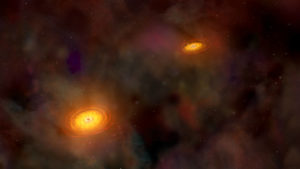A Remarkable Chance Encounter:
Thanks to happenstance and a 4-VA grant to investigate the origins of super massive black holes (SMBH), Professor of Physics and Astronomy Shobita Satyapal and her team discovered a noteworthy find: A distant colliding galaxy hosting a binary active galactic nucleus (AGN).
This significant revelation is important because although there are strong theoretical rationales why binary AGN should exist, finding them is extremely rare – as only a handful have currently been identified with separations of less than a few tens of light years apart. With Satyapal’s sighting, a supposition was developed that a significant population of binary AGNs may be hidden from optical wavelengths. A heavenly breakthrough.
It’s where you look and how you look
Thus begat a concerted collaborative effort between Satyapal’s group at Mason, with their expertise in analysis of X-ray data; Dr. Anca Constantin at Madison who established a program to study the reduction of data from the Large Binocular Telescope (LBT) in Arizona; and Dr. Sabrina Stierwalt from UVA — an expert on very large array (VLA) data.
Their goals?
- To determine the true frequency of binary AGNs and to estimate their black hole masses
- To compare AGN incidences and properties to host galaxy and merger potential
- To compare infrared-selected binary AGNs to optically-identified binary AGNs
Then, the search was on to find binary AGNs in a sample of 15 colliding galaxies for which the team secured highly competitive Chandra and XMM-Newton observations. Each participating university brought on both graduates and undergraduates to assist in data analysis and modeling.
Their results?
 They found a notable eight additional binary AGNs in their sample of 15 — increasing the fraction of known binary AGNs in the universe at these close separations by 30%!
They found a notable eight additional binary AGNs in their sample of 15 — increasing the fraction of known binary AGNs in the universe at these close separations by 30%!
What’s more, the study resulted in a NASA press release recognizing Mason; an accepted publication in the Astrophysical Journal (with another in the works). Further, the collaboration encouraged an undergrad from Madison to move forward into Mason’s graduate program — helping build an even stronger bridge between the two institutions.
“This 4-VA funding gave us the seed money which allowed us to do the exploring we needed at the outset of this project,” explains Satyapal. “What began as a lucky accident has morphed in to a statewide study which has received national and international attention and garnered additional research dollars – for that we are very grateful!”
